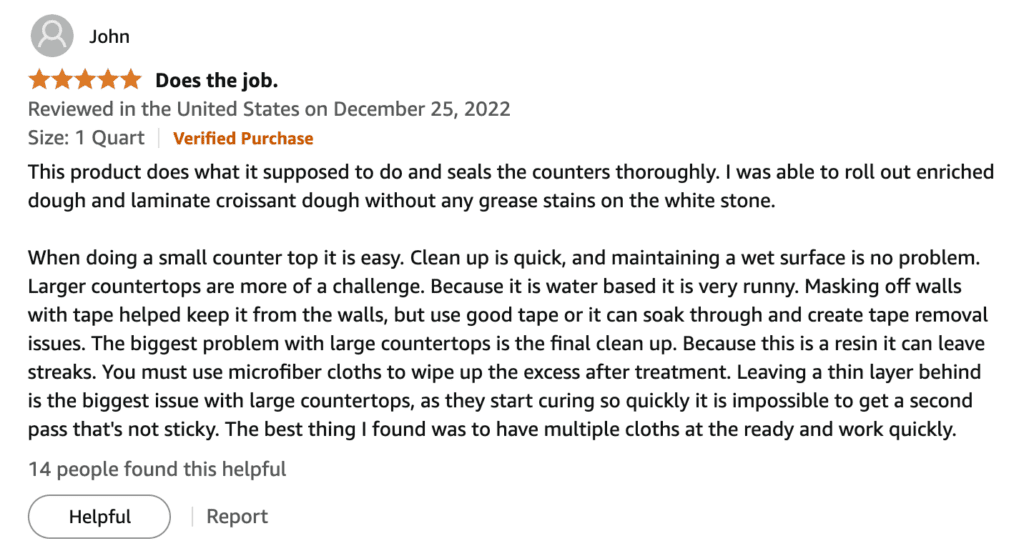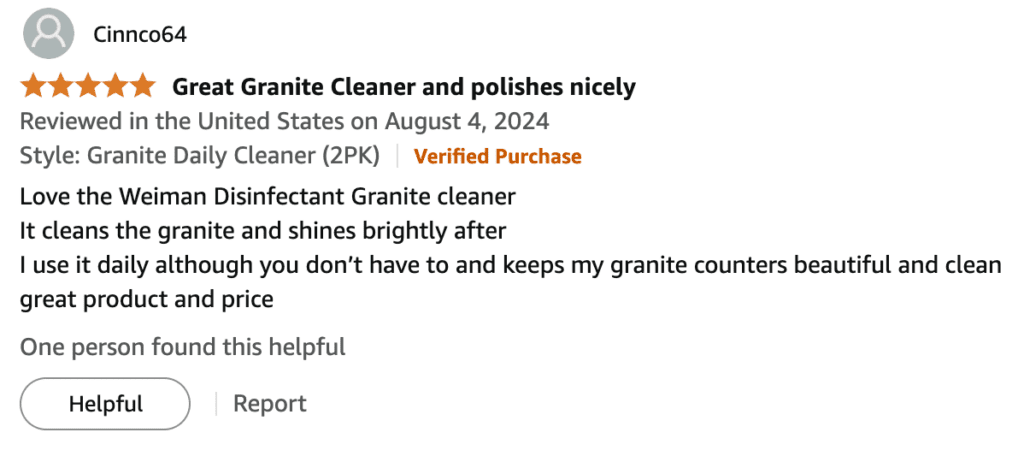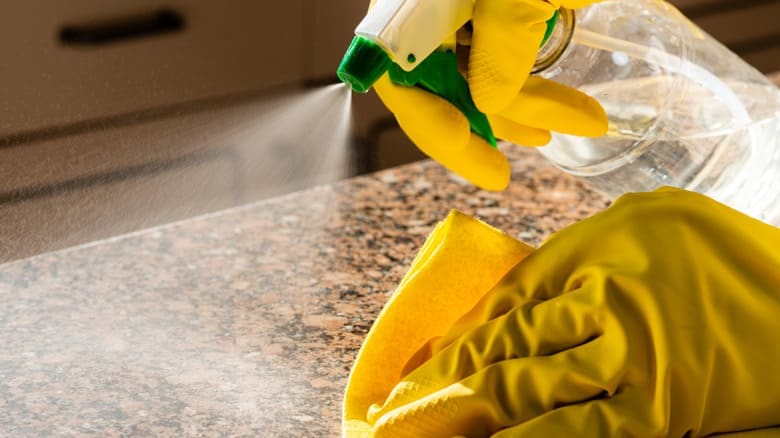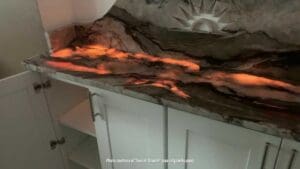Natural granite pattern
Introduction
Granite is one of the most popular materials for kitchen countertops, valued for its elegance, durability, and longevity. With proper care, it can last over 100 years while maintaining its pristine appearance. However, to preserve its beauty and strength, regular maintenance is essential.A common question from our readers is : “Do special products protect granite countertops from dirt or not?” Let’s explore the answer
We’ve created a comprehensive guide to help you properly care for your granite countertops. In this article, we’ll share expert insights from stone fabrication and installation specialists and provide step-by-step instructions on sealing and maintaining granite countertops. With the right care, your countertops will retain their beauty and functionality for years to come.
1. Why Is Sealing Granite Countertops Important?
Granite is well known for its resistance to scratches and mechanical damage, making it a popular choice for kitchen countertops. However, many people overlook the fact that granite is a porous natural stone, meaning it can absorb liquids such as oil, wine, juice, and even water. Without proper sealing, these liquids can seep deep into the stone, leading to stubborn stains and potential damage. Sealing granite helps protect its surface, preserving both its appearance and durability over time.
This is exactly why sealing granite countertops is essential. The sealant forms a protective barrier, preventing moisture and contaminants from penetrating the stone. This not only preserves the countertop’s pristine appearance but also extends its lifespan significantly. Without proper sealing, granite can lose its natural luster, and cleaning becomes much more challenging.
To keep your granite countertop looking beautiful and long-lasting, regular sealing is an essential part of its maintenance!
2. What materials do you need to seal granite countertops?
Before sealing your granite countertops, ensure you have all the necessary tools and materials. Here’s what you’ll need:
1. Granite Sealer
The type of sealer you choose should be suited to the specific granite you’re working with. For optimal protection, water-repellent sealers are the best option, as they effectively shield the surface from moisture, stains, and dirt.
- Miracle Sealants 511 Impregnator Penetrating Sealer
Price: about $25 for 16 ounces (473 ml)
 Review taken from amazon.com
Review taken from amazon.com
- StoneTech BulletProof Sealer
Price: about $45 for 16 ounces (473 ml).
 Review taken from amazon.com
Review taken from amazon.com
2. Soft rags or sponges
Use soft cloths or sponges to apply the sealer and remove any excess without damaging the granite surface..
- Scotch-Brite Non-Scratch Scrub Sponges
Price: Approximately $4 for a pack of 6.
3. Gloves
Wear gloves to protect your hands from the chemicals in sealants and cleaning products.
- Rubbermaid Commercial Safety Gloves
Approximately $8 per pair.
4. Granite cleaner:
Used for thoroughly cleaning the countertop before applying the sealer.
- Weiman Granite Cleaner and Polish
Price: about $10 for 22 ounces (650 ml).
 Review taken from amazon.com
Review taken from amazon.com
5. Plastic sheeting or painter's tape (optional)
Helps protect surrounding surfaces from accidental sealant spills or contact.
- Scotch Painter's Tape
Price: about $5 per roll.
3. How to Seal Granite Countertops: A Step-by-Step Guide
 Image Source: Pexels Stock Photo
Image Source: Pexels Stock Photo
Sealing a granite countertop is a straightforward process, but it requires precision and patience. We've prepared a detailed step-by-step guide to help you apply the sealant correctly, ensuring long-lasting protection for your granite countertop.
Step 1: Surface Preparation
Before applying the sealer, thoroughly clean the countertop to remove dirt, grease, and food residue. Use Weiman Granite Cleaner & Polish for effective cleaning. Wipe the surface with a soft cloth or sponge, avoiding abrasive materials to prevent scratching or damaging the granite.
Step 2: Before starting, ensure you have all the necessary supplies: sealer, soft rags, gloves, a plastic spatula for excess removal, and protective film for surrounding surfaces (if needed).
Step 3: Apply the sealant
Pour a small amount of sealer onto a soft rag or sponge, then spread it evenly across the granite countertop. Start from one corner and work your way across the entire surface, ensuring thorough and consistent coverage.
Tip: Spread the sealant evenly in a thin layer to prevent excess buildup, pooling, or streaks.
Step 4: Waiting Time
Let the sealer sit on the countertop for 15 to 20 minutes, allowing it to fully absorb into the granite’s pores. Afterward, gently wipe away any excess with a soft cloth to ensure a smooth, even finish.
Step 5: Apply a Second Coat for Maximum Protection.
For optimal protection, applying a second coat of sealer is recommended. Repeat steps 3 and 4, ensuring the sealant dries between coats as directed on the product packaging.
Step 6: Check the sealant
Once the final coat of sealer has dried, test its effectiveness. Place a few drops of water on the countertop surface. If the water beads up and remains on the surface without being absorbed, the sealing has been successfully applied.
Step 7: Allow the Sealer to Set
Allow the sealer to dry completely—this typically takes 1–2 hours. However, for the best results, let the countertop sit undisturbed for 24 hours before using it.
4. Caring for Granite Countertops After Sealing

Source: World Class Granite (worldclassgranite.com)
After sealing your countertop, proper care is essential to ensure the protective layer remains effective for years. Here are some key maintenance tips:
1. Regular cleaning
For daily maintenance, use a soft cloth and warm water with a small amount of mild detergent. Avoid abrasive cleaners or acidic substances like vinegar, as they can damage the granite surface over time.
2. Stain removal
If stains appear on the countertop, use a specialized granite cleaner or stain remover to lift them effectively. Alternatively, a paste of water and baking soda can help remove food and drink stains
3. Reapply Sealer Every 1 to 2 Years
Even with proper sealing, the protective layer wears down over time. To maintain durability and stain resistance, it’s recommended to reapply the sealer every 1 to 2 years, depending on usage frequency.
4. Protection from high temperatures
Although granite is heat-resistant, placing hot pots or pans directly on the surface is not recommended. Always use trivets or heat-resistant mats to prevent potential damage and maintain the countertop’s integrity.
5. Common Granite Care Mistakes and How to Avoid Them
1. Use of abrasive cleaning agents
Harsh, abrasive cleaning agents can scratch and dull the granite surface over time. Instead, use soft cloths or sponges along with gentle, pH-neutral cleaners for safe and effective cleaning.
2. Selecting the Wrong Sealant
Using the wrong sealant can cause it to wear off quickly or even harm the granite surface. Always choose a high-quality sealer made for granite countertops to keep them protected and long-lasting.
3. Ignoring regular sealing
Without proper resealing, granite can absorb liquids, leading to stains and damage. Regularly check the sealant’s condition and reapply as needed to maintain protection.
6. The Right Way to Clean Granite Countertops.
Be careful not to damage the surface while cleaning. Follow these guidelines:
- Use a mild detergent – Any non-abrasive cleaner designed for stone surfaces is suitable for regular cleaning.
- Avoid acidic cleaners – Do not use vinegar, lemon juice, or other acidic substances, as they can weaken the sealant and damage the granite.
- Wipe up spills immediately – Prevent liquids from being absorbed by cleaning up spills right away.
7. Professional Care and Sealing for granite countertops
If you're unsure about sealing or maintaining your granite countertops yourself, professional help is always an option! Experts can properly apply the sealant and recommend the best care products to keep your countertops in top condition.
How to choose a professional?
- Look for Reviews & Recommendations – Check testimonials from past clients or seek referrals from people you trust.
- Verify Materials – Ensure the company uses high-quality sealants specifically designed for granite countertops.
- Assess Experience – Choose a company with a proven track record in granite care and sealing.
Frequently Asked Questions about sealing and maintaining granite countertops
Our readers often ask how to properly seal and maintain granite countertops to preserve their beauty and durability. We've gathered the most frequently asked questions and provided detailed answers to help you care for your countertops effectively!
How Often Should I Seal My Granite Countertops?
It is recommended to reapply the sealant every 1–2 years, depending on the countertop's usage and exposure. If the surface frequently comes into contact with water, oils, or acidic liquids (such as lemon juice or vinegar), the sealant may wear down faster, requiring more frequent resealing.
Can I use regular wood or tile sealer on granite countertops?
No, granite requires a specialized sealer formulated for natural stone. Regular wood or tile sealers do not properly absorb into granite and fail to provide effective protection against moisture and stains. The best option is a penetrating sealer, which deeply fills the stone’s pores, preventing damage and ensuring long-lasting durability.
How to Remove a Stain from a Granite Countertop?
If a stain doesn’t come off with regular cleaning, try these methods:
- Use a specialized granite cleaner – Products like StoneTech Oil Stain Remover are designed to lift stains effectively.
- Apply a baking soda paste – Mix baking soda and water, apply it to the stain, leave it for 24 hours, then wipe it off with a damp cloth.
- Use hydrogen peroxide or acetone – Effective for stubborn oil stains, but not recommended for dark granite, as it may cause discoloration.
Important! Act as quickly as possible to prevent the liquid from penetrating the stone and leaving permanent marks.
What Happens If a Granite Countertop Is Not Sealed?
If a granite countertop is not sealed, the following issues may arise over time:
- Liquid absorption and stains — Granite is a porous material. Without a sealer, it easily absorbs water, oils, wine, coffee, and other liquids, resulting to stubborn stains.
- Bacteria and mold growth — Moisture and dirt can accumulate in the stone’s pores of unsealed granite, creating a ground for bacteria and mold.
- Dulling and loss of shine — Over time, the surface may lose its polished look as grease and dirt seep into the granite.
- Increased sensitivity to acids — Although more acid-resistant than marble, unsealed granite can still be damaged by lemon juice, vinegar, and other acidic substances, which can penetrate the stone and cause deterioration.
- Cracks and structural damage —Water and contaminants absorbed over time can lead to microcracks, especially when exposed to temperature changes.
Conclusion
Granite countertops are not only beautiful but also practical when properly maintained. While caring for them may seem overwhelming at first, it’s actually quite simple when you follow the right recommendations. We hope our tips help you keep your countertop in perfect condition allowing you to enjoy it for years to come !
Remember, granite countertops are a long-term investment, and they deserve care and attention. If your granite countertop has lost its original shine and it’s time for a replacement, don’t waste hours searching for contractors! The First National Ranking of Stone Countertop Fabricators and Installers in the U.S. makes it easy to find top-rated professionals to ensure high-quality results.
If you have any questions or additional thoughts, don’t hesitate to reach out—we’re always happy to help and provide expert advice!



 Review taken from amazon.com
Review taken from amazon.com Review taken from amazon.com
Review taken from amazon.com  Review taken from amazon.com
Review taken from amazon.com Image Source: Pexels Stock Photo
Image Source: Pexels Stock Photo








